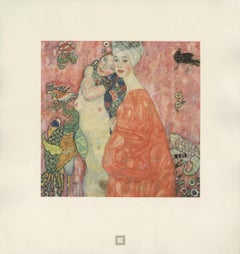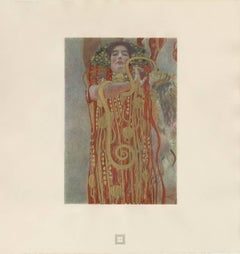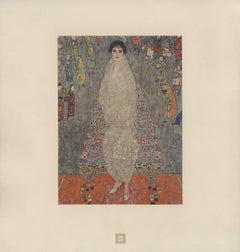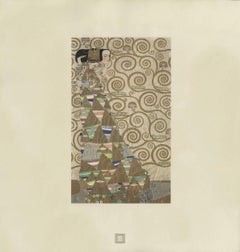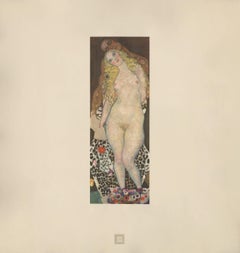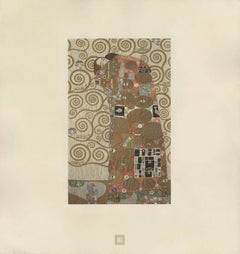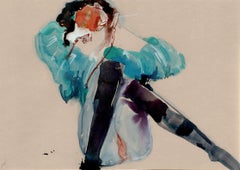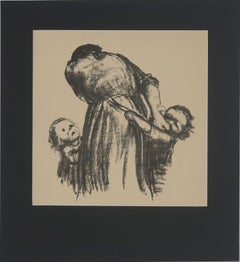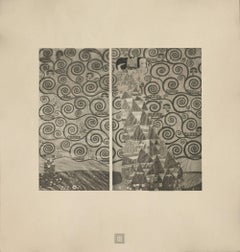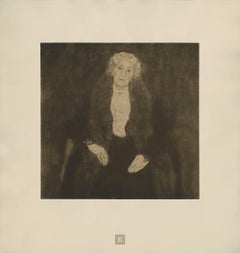(after) Gustav Klimt Figurative Prints
Austrian, 1862-1918
Gustav Klimt was an Austrian symbolist painter and a prominent member of the Vienna Secession movement. Klimt's primary subject was the female body and his works are mostly erotic in nature.to
1
17
Overall Width
to
Overall Height
to
15
2
1
28
860
698
375
309
18
2
15
1
9
8
1
15
13
12
4
4
3
3
3
2
2
1
1
1
1
1
1
1
15
2
1
1
16
Artist: (after) Gustav Klimt
Max Eisler Eine Nachlese folio "Girlfriends II" collotype print
By (after) Gustav Klimt
Located in Chicago, IL
After Gustav Klimt, Max Eisler #1, Die Freundinnen II; multi-color collotype after 1916/17 painting in oil on canvas which was destroyed by fire in May 1945 at Immendorf Castle Lower Austria.
Eisler’s choice to begin his 1931 portfolio of works by Klimt with Girlfriends II was both bold and prescient. Just 14 years later, the painting was tragically destroyed in a fire. With such a loss, this rare and exquisite image is all the more valuable by virtue of having been made in color. In works from his late period, Klimt continued his fascination with exploring female dynamics and their various forms of love. Girlfriends II is a fine example of how space, color and ornament play a noticeable role in the evolution of his symbolic language. Wide swaths of space in the background as well as the two female forms create the structure. Klimt’s strong brushstrokes show a painterly quality and a new move toward abstraction which feels very far away from his earlier work. Nor should Klimt’s economy of line be overlooked. His draughtsmanship is what infuses the female bodies with movement, emotion and a profundity of life. Both women confront the viewer’s gaze unselfconsciously, as if they are modern-day Viennese women stepping out of a Klimtesque ukiyo-e print. Characteristic of this late period, Klimt uses ornament...
Category
1930s Vienna Secession (after) Gustav Klimt Figurative Prints
Materials
Paper
Max Eisler Eine Nachlese folio “Hygieia” collotype print
By (after) Gustav Klimt
Located in Chicago, IL
After Gustav Klimt, Max Eisler #10, Ausschnitt aus dem Bilde “Medizin”; multi-color collotype detail from Medicine, one of the faculty paintings for the Uni...
Category
1930s Vienna Secession (after) Gustav Klimt Figurative Prints
Materials
Paper
Max Eisler Eine Nachlese folio “Portrait of Baroness Bachofen-Echt” collotype
By (after) Gustav Klimt
Located in Chicago, IL
After Gustav Klimt, Max Eisler #22, Bildnis Baronin Bachofen-Echt; multi-color collotype after 1914-1916 painting in oil on canvas.
GUSTAV KLIMT EINE NACHLESE (GUSTAV KLIMT AN AFTERMATH), a portfolio of 30 collotypes prints, 15 are multi-color and 15 are monochrome, on chine colle paper laid down on heavy cream-wove paper with deckled edges; Max Eisler, Editor-Publisher; Osterreichischer Staatsdruckerei (Austrian State Printing Office), Printer; in a limited edition of 500 numbered examples of which: 200 were printed in German, 150 were printed in French and 150 were printed in English; Vienna, 1931.
2018 marks the 100th anniversary of Gustav Klimt’s death. It is a fitting time to reflect upon the enduring legacy and deep impact of his art. Recognizing this need for posterity with uncanny foresight, the publication of Gustav Klimt: An Aftermath (Eine Nachlese) provides a rare collection of work after Klimt which has proven to be an indispensable tool for Klimt scholarship as well as a source for pure visual delight.
Approximately 25 percent of the original works featured in the Aftermath portfolio have since been lost. Of those 30, six were destroyed by fire on 8 May 1945. On that fateful final day of WWII, the retreating Feldherrnhalle, a tank division of the German Army, set fire to the Schloss Immendorf which was a 16th century castle in Lower Austria used between 1942-1945 to store objects of art. All three of Klimt’s Faculty Paintings: Philosophy, Medicine and Jurisprudence (1900-1907), originally created for the University of Vienna, were on premises at that time. Also among the inventory of Klimt paintings in storage there was art which had been confiscated by the Nazis. One of the most significant confiscated collections was the Lederer collection which featured many works by Gustav Klimt such as Girlfriends II and Garden Path with Chickens...
Category
1930s Vienna Secession (after) Gustav Klimt Figurative Prints
Materials
Archival Paper
Max Eisler Eine Nachlese folio “Expectation” collotype print
By (after) Gustav Klimt
Located in Chicago, IL
After Gustav Klimt, Max Eisler #12, Aus dem Stoclet-Fries: Erwartung; multi-color collotype after the cartoon for the 1910-1911 mosaic frieze on the west wa...
Category
1930s Vienna Secession (after) Gustav Klimt Figurative Prints
Materials
Paper
Max Eisler Eine Nachlese folio “Adam & Eve” collotype print
By (after) Gustav Klimt
Located in Chicago, IL
After Gustav Klimt, Max Eisler #20, Adam und Eva; multi-color collotype after unfinished 1917/18 painting in oil on canvas.
GUSTAV KLIMT EINE NACHLESE (GUSTAV KLIMT AN AFTERMATH), a...
Category
1930s Vienna Secession (after) Gustav Klimt Figurative Prints
Materials
Paper
Max Eisler Eine Nachlese folio “The Embrace (Fulfillment)” collotype print
By (after) Gustav Klimt
Located in Chicago, IL
After Gustav Klimt, Max Eisler #17, Aus dem Stoclet-Fries: Die Umarmung; multi-color collotype after the cartoon for the 1910-1911 mosaic frieze on the east wall of the dining hall o...
Category
1930s Vienna Secession (after) Gustav Klimt Figurative Prints
Materials
Paper
Max Eisler Eine Nachlese folio "Portrait of Serena Lederer" collotype
By (after) Gustav Klimt
Located in Chicago, IL
After Gustav Klimt, Max Eisler Plate #6, Bildnis Frau Serena Lederer; grey monochrome collotype after the 1905 painting in oil on canvas.
GUSTAV KLIMT EINE NACHLESE (GUSTAV KLIMT AN...
Category
1930s Vienna Secession (after) Gustav Klimt Figurative Prints
Materials
Paper
Max Eisler Eine Nachlese folio "Baby" collotype
By (after) Gustav Klimt
Located in Chicago, IL
After Gustav Klimt, Max Eisler Plate #25, Baby; black & white collotype after the 1917 painting in oil on canvas.
GUSTAV KLIMT EINE NACHLESE (GUSTAV KLIMT ...
Category
1930s Vienna Secession (after) Gustav Klimt Figurative Prints
Materials
Paper
Max Eisler Eine Nachlese folio "Charlotte Pulitzer" collotype
By (after) Gustav Klimt
Located in Chicago, IL
After Gustav Klimt, Max Eisler Plate #19, Bildnis einer alten Dame; sepia-toned monochrome collotype after the 1917 painting in oil on canvas.
GUSTAV KLIMT EINE NACHLESE (GUSTAV KLIMT AN AFTERMATH), a portfolio of 30 collotypes prints, 15 are multi-color and 15 are monochrome, on chine colle paper laid down on heavy cream-wove paper with deckled edges; Max Eisler, Editor-Publisher; Osterreichischer Staatsdruckerei (Austrian State Printing Office), Printer; in a limited edition of 500 numbered examples of which: 200 were printed in German, 150 were printed in French and 150 were printed in English; Vienna, 1931.
2018 marks the 100th anniversary of Gustav Klimt’s death. It is a fitting time to reflect upon the enduring legacy and deep impact of his art. Recognizing this need for posterity with uncanny foresight, the publication of Gustav Klimt: An Aftermath (Eine Nachlese) provides a rare collection of work after Klimt which has proven to be an indispensable tool for Klimt scholarship as well as a source for pure visual delight.
Approximately 25 percent of the original works featured in the Aftermath portfolio have since been lost. Of those 30, six were destroyed by fire on 8 May 1945. On that fateful final day of WWII, the retreating Feldherrnhalle, a tank division of the German Army, set fire to the Schloss Immendorf which was a 16th century castle in Lower Austria used between 1942-1945 to store objects of art. All three of Klimt’s Faculty Paintings: Philosophy, Medicine and Jurisprudence (1900-1907), originally created for the University of Vienna, were on premises at that time. Also among the inventory of Klimt paintings in storage there was art which had been confiscated by the Nazis. One of the most significant confiscated collections was the Lederer collection which featured many works by Gustav Klimt such as Girlfriends II and Garden Path with Chickens. In many instances, Aftermath is our only link to these lost treasures.
Max Eisler (1881-1937), the publisher of the 1931 Aftermath portfolio, was an art historian at Vienna University specializing in modern and contemporary arts and crafts whose 1920 book on Klimt was the first Klimt monograph. He saw An Aftermath as filling-in important gaps left by the earlier print portfolios which had only featured Klimt up to 1913 and which had glossed over major art projects such as the Tree of Life frieze for the Palais Stoclet. And whereas only 10 of the 50 prints from the earlier portfolios published by H.O. Miethke were made in intricate multi-color images, Eisler augmented the earlier format by featuring half of the 30 images in stunning multi-colored collotypes. Understanding the fragile nature of the collotype printing process also reinforces this project’s distinctive and exceptional characteristics. Fragile collotype plates can not be reused. As such, this necessitates the completion of a run on the first go and also dictates a limited production number. Printed by hand, the collotypes required deft handling by the printer, Osterreichische Staatsdruckerei. A complicated and lengthy process involving gelatin colloids mixed with dichromates, the creation of 16 color separation thin glass filters to achieve the light-sensitive internegative images which could faithfully capture all of the painting’s tonal gradations and colors, exposure to actinic light, and delicate chine collie papers which allowed for greater color saturation, the printer’s collaborative role in capturing and transmitting Klimt’s nuanced paint strokes is nothing short of remarkable.
The Österreichische Staatsdruckerei (Austrian State Printing Office), was the successor to the KK Hof -und Staatsdruckerei which was founded by Emperor Franz I in 1804 and whose collotype printing innovations of Klimt’s art...
Category
1930s Vienna Secession (after) Gustav Klimt Figurative Prints
Materials
Archival Paper
Max Eisler Eine Nachlese folio “Allegory of Life and Death” collotype print
By (after) Gustav Klimt
Located in Chicago, IL
After Gustav Klimt, Max Eisler #18, Der Tod und das Leben; multi-color collotype after original painting (1910-1916) in oil on canvas.
GUSTAV KLIMT EINE NACHLESE (GUSTAV KLIMT AN AF...
Category
1930s Vienna Secession (after) Gustav Klimt Figurative Prints
Materials
Paper
Max Eisler Eine Nachlese folio "Portrait of Baroness Wittgenstein" collotype
By (after) Gustav Klimt
Located in Chicago, IL
After Gustav Klimt, Max Eisler Plate #4, Bildnis Baronin Wittgenstein; dark grey monochrome collotype after the 1905 painting in oil on canvas.
GUSTAV KLIMT EINE NACHLESE (GUSTAV KLIMT AN AFTERMATH), a portfolio of 30 collotypes prints, 15 are multi-color and 15 are monochrome, on chine colle paper laid down on heavy cream-wove paper with deckled edges; Max Eisler, Editor-Publisher; Osterreichischer Staatsdruckerei (Austrian State Printing Office), Printer; in a limited edition of 500 numbered examples of which: 200 were printed in German, 150 were printed in French and 150 were printed in English; Vienna, 1931.
2018 marks the 100th anniversary of Gustav Klimt’s death. It is a fitting time to reflect upon the enduring legacy and deep impact of his art. Recognizing this need for posterity with uncanny foresight, the publication of Gustav Klimt: An Aftermath (Eine Nachlese) provides a rare collection of work after Klimt which has proven to be an indispensable tool for Klimt scholarship as well as a source for pure visual delight.
Approximately 25 percent of the original works featured in the Aftermath portfolio have since been lost. Of those 30, six were destroyed by fire on 8 May 1945. On that fateful final day of WWII, the retreating Feldherrnhalle, a tank division of the German Army, set fire to the Schloss Immendorf which was a 16th century castle in Lower Austria used between 1942-1945 to store objects of art. All three of Klimt’s Faculty Paintings: Philosophy, Medicine and Jurisprudence (1900-1907), originally created for the University of Vienna, were on premises at that time. Also among the inventory of Klimt paintings in storage there was art which had been confiscated by the Nazis. One of the most significant confiscated collections was the Lederer collection which featured many works by Gustav Klimt such as Girlfriends II and Garden Path with Chickens...
Category
1930s Vienna Secession (after) Gustav Klimt Figurative Prints
Materials
Paper
Max Eisler Eine Nachlese folio "Lady in a Feathered Hat" collotype
By (after) Gustav Klimt
Located in Chicago, IL
After Gustav Klimt, Max Eisler Plate #2, Dame mit Blumenhut (aka The Violet Hat); sepia monochrome collotype after the 1909 painting in oil on canvas.
...
Category
1930s Vienna Secession (after) Gustav Klimt Figurative Prints
Materials
Paper
PORTRAIT OF ADELE BLOCH-BAUER plate
By (after) Gustav Klimt
Located in New York, NY
Artist Reproduction plate. Edition 1401A
Reihe "Gustav Klimt – Phantastische Meisterwerke" mit einem diagonalen Durchmesser von 22 cm und einer Goldumrandung an. Es handelt sich dabei um die Ausgabe "...." aus dem Jahr 1990, Teller-Nr. ?, die als Reproduktion im Auftrag des Hauses Lilien Porzellan...
Category
1990s Art Deco (after) Gustav Klimt Figurative Prints
Materials
Porcelain
Sketch for a Frieze - Original Collotype Print - 1919
By (after) Gustav Klimt
Located in Roma, IT
Sketch for a Frieze is a vintage, beautiful, and rare collotype from “Gustav Klimt: Fünfundzwanzig Handzeichnungen”, a limited-edition collection of 25 monochrome and two-color collotypes after drawings by Gustav Klimt.
Published by Gilhofer and Ranschburg, Vienna, July 1919, just one year after Klimt...
Category
1910s Modern (after) Gustav Klimt Figurative Prints
Materials
Black and White
Max Eisler Eine Nachlese folio “The Bride” collotype print
By (after) Gustav Klimt
Located in Chicago, IL
After Gustav Klimt, Max Eisler #30, Brautzug; multi-color collotype after unfinished 1917/18 painting in oil on canvas.
Painted in the last months of Klimt’s life, The Bride was one...
Category
1930s Vienna Secession (after) Gustav Klimt Figurative Prints
Materials
Paper
Max Eisler Eine Nachlese folio "Wally" (Girl in Profile) collotype
By (after) Gustav Klimt
Located in Chicago, IL
After Gustav Klimt, Max Eisler Plate #27, Madchen im Profile; grey-toned monochrome collotype after the 1916 painting in oil on canvas. Original destroyed by fire May 1945.
GUSTAV K...
Category
1930s Vienna Secession (after) Gustav Klimt Figurative Prints
Materials
Paper
Sketched Portrait - 1910s - Original Collotype Print by Gustav Klimt
By (after) Gustav Klimt
Located in Roma, IT
Sketched Portrait is a vintage, beautiful, and rare collotype from “Gustav Klimt: Fünfundzwanzig Handzeichnungen”, a limited-edition collection of 25 monochrome and two-color collotypes after drawings by Gustav Klimt.
Published by Gilhofer and Ranschburg, Vienna, July 1919, just one year after Klimt...
Category
1910s Modern (after) Gustav Klimt Figurative Prints
Materials
Black and White
Max Eisler Eine Nachlese folio "Portrait of Friederike Marie Beer" collotype
By (after) Gustav Klimt
Located in Chicago, IL
After Gustav Klimt, Max Eisler Plate #24, Bildnis Friederike Maria Beer; multi-color collotype after the 1916 painting in oil on canvas.
GUSTAV KLIMT EINE NACHLESE (GUSTAV KLIMT AN ...
Category
1930s Vienna Secession (after) Gustav Klimt Figurative Prints
Materials
Paper
Related Items
nude erotic print
Located in Roma, GB
erotic print
female figure captured in a moment of an intimate delight. Flame orange color, shining blue, and clown-like intriguing face. lack and white.
Parts of her body appear...
Category
21st Century and Contemporary Vienna Secession (after) Gustav Klimt Figurative Prints
Materials
Paper, Color, Digital
"Bread" lithograph by Käthe Kollwitz
By Käthe Kollwitz
Located in Soquel, CA
Bold lithograph titled "Bread" by Kathe Kollwitz (German, 1867-1945). This piece is one of the Lithographic reproductions of the original lithographs, plate 2 from a series of 10, pr...
Category
1940s Expressionist (after) Gustav Klimt Figurative Prints
Materials
Paper, Ink, Lithograph
erotic print nu poster
Located in Roma, GB
nude print
limited edition
print on paper
hand signed
certificate of authenticity
'Thanks to this psychological analysis, my paintings show emotions that people never experience ...
Category
21st Century and Contemporary Vienna Secession (after) Gustav Klimt Figurative Prints
Materials
C Print, Color, Digital, Paper
"Death Takes The Children" lithograph by Käthe Kollwitz
By Käthe Kollwitz
Located in Soquel, CA
Bold print of "Death Takes the Children" by Kathe Kollwitz (German, 1867-1945). This piece is one of the Lithographic reproductions of the original lithographs, plate 9 from a series...
Category
1940s Expressionist (after) Gustav Klimt Figurative Prints
Materials
Paper, Ink, Lithograph
H 18 in W 22 in D 0.25 in
"By the Canal" Limited Edition Lithograph on Archival Paper
Located in Soquel, CA
"By the Canal" Limited Edition Lithograph on Archival Paper
Vibrant lithograph of a red-headed woman near a canal by Michael Leu (Taiwanese, b. 1950). The woman is holding a bouquet of tulips. Nearby, a bicycle is parked alongside the canal. There is a bridge over the canal, connecting to a small town in the distance. This piece is whimsical, bold, and expressive.
Numbered "31/198" in the lower left corner.
Signed and dated "Michal Leu 95" in the lower right corner.
Presented in a black aluminum frame with a white mat.
Frame size: 32.75"H x 27.25"W
Image size: 24"H x 19"W
Born in Taipei, Taiwan, Michael Leu (b. 1950) studied fine art and design in his home town in the late 1960s and learned printmaking techniques at Otis Parsons...
Category
1990s Expressionist (after) Gustav Klimt Figurative Prints
Materials
Ink, Archival Paper, Lithograph
H 32.75 in W 27.25 in D 1 in
Original Vintage Secession Poster celebrating the emperor's jubilee
Located in Zurich, CH
Original Vintage Poster by the Austrian artist Ferdinand Ludwig Graf, a member of the Hagenbund. This Viennese artist association moved as soon a...
Category
Early 1900s Vienna Secession (after) Gustav Klimt Figurative Prints
Materials
Paper
H 48.82 in W 36.42 in D 0.04 in
portrait Angie
Located in Roma, GB
free shipping standard parcel available
to be confirmed while submitting the order
artist: Anastasia Aureum
paper print
limited edition
hand signed
About the artwork:
This portra...
Category
21st Century and Contemporary Vienna Secession (after) Gustav Klimt Figurative Prints
Materials
Paper, Color, Digital
Polish French Figurative Abstract Art Brut Expressionist Lithograph Maryan
By Pinchas Maryan
Located in Surfside, FL
Pinchas Burstein, known as Maryan
Lithograph (after the drawing).
1960
Dimensions: 12 3/8 x 9 3/8 inches (315 x 240mm).
Gold or bronze ink on black paper
Signed in the plate, not b...
Category
1960s Expressionist (after) Gustav Klimt Figurative Prints
Materials
Paper, Lithograph
Tip of Broadway II
By Lester Johnson
Located in Buffalo, NY
An original lithograph created by Lester F. Johnson. This work was donated to Hallwalls Contemporary Art Center by the David K. Anderson Charitable Trust. All proceeds from the sal...
Category
1970s Expressionist (after) Gustav Klimt Figurative Prints
Materials
Paper, Lithograph
Mädchen am Fenster. 1906-08.
By Oskar Kokoschka
Located in New York, NY
Mädchen am Fenster. 1906-08. Color lithograph printed on smooth card stock. Full margins. Tipped into a later presentaion folder, signed by the artist in pencil, on the recto. Published by the Wiener Werkstätte, Vienna, with the printed postcard text on verso. Among Kokoschka's earliest prints were a series of 14 postcards, the current work and the following lot that he produced for the Wiener Werkstätte. Wingler/Welz 4.
Oskar Kokoschka was an Austrian artist, poet and playwright best known for his intense expressionistic portraits...
Category
Early 1900s Vienna Secession (after) Gustav Klimt Figurative Prints
Materials
Lithograph
Die Grosse Befehl - Illustrated Book by Max Pechstein - 1933
By Hermann Max Pechstein
Located in Roma, IT
Die Grosse Befehl is an original Rare Book illustrated by Hermann Max Pechstein (Zwickau, December 31, 1881 – Berlin, June 29, 1955) and written by Johanne...
Category
1930s Expressionist (after) Gustav Klimt Figurative Prints
Materials
Paper
H 9.85 in W 5.91 in D 0.4 in
Studies - Original Offset and Lithograph by George Grosz - 1923
By George Grosz
Located in Roma, IT
Studies is an original offset and lithograph realized by George Grosz.
The artwork is the plate n.10 from the portfolio Ecce Homo published between 1922/1923, edition of Der Malik-V...
Category
1920s Expressionist (after) Gustav Klimt Figurative Prints
Materials
Lithograph, Paper, Offset
H 9.65 in W 13.98 in D 0.08 in
Previously Available Items
Max Eisler Eine Nachlese folio "Studies for the Frieze at Palais" 4 collotypes
By (after) Gustav Klimt
Located in Chicago, IL
After Gustav Klimt, Max Eisler Plates #13-16, black & white collotypes after the 1911 cartoon originally in crayon, graphite pencil, gouache and metal powders.
#13 Der Lebensbaum (An...
Category
1930s Vienna Secession (after) Gustav Klimt Figurative Prints
Materials
Archival Paper
Max Eisler Eine Nachlese folio "Charlotte Pulitzer" collotype
By (after) Gustav Klimt
Located in Chicago, IL
After Gustav Klimt, Max Eisler Plate #19, Bildnis einer alten Dame; sepia-toned monochrome collotype after the 1917 painting in oil on canvas.
GUSTAV KLIMT EINE NACHLESE (GUSTAV KLIMT AN AFTERMATH), a portfolio of 30 collotypes prints, 15 are multi-color and 15 are monochrome, on chine colle paper laid down on heavy cream-wove paper with deckled edges; Max Eisler, Editor-Publisher; Osterreichischer Staatsdruckerei (Austrian State Printing Office), Printer; in a limited edition of 500 numbered examples of which: 200 were printed in German, 150 were printed in French and 150 were printed in English; Vienna, 1931.
2018 marks the 100th anniversary of Gustav Klimt’s death. It is a fitting time to reflect upon the enduring legacy and deep impact of his art. Recognizing this need for posterity with uncanny foresight, the publication of Gustav Klimt: An Aftermath (Eine Nachlese) provides a rare collection of work after Klimt which has proven to be an indispensable tool for Klimt scholarship as well as a source for pure visual delight.
Approximately 25 percent of the original works featured in the Aftermath portfolio have since been lost. Of those 30, six were destroyed by fire on 8 May 1945. On that fateful final day of WWII, the retreating Feldherrnhalle, a tank division of the German Army, set fire to the Schloss Immendorf which was a 16th century castle in Lower Austria used between 1942-1945 to store objects of art. All three of Klimt’s Faculty Paintings: Philosophy, Medicine and Jurisprudence (1900-1907), originally created for the University of Vienna, were on premises at that time. Also among the inventory of Klimt paintings in storage there was art which had been confiscated by the Nazis. One of the most significant confiscated collections was the Lederer collection which featured many works by Gustav Klimt such as Girlfriends II and Garden Path with Chickens...
Category
1930s Vienna Secession (after) Gustav Klimt Figurative Prints
Materials
Archival Paper
Max Eisler Eine Nachlese folio "Studies for the Frieze at Palais" 4 collotypes
By (after) Gustav Klimt
Located in Chicago, IL
After Gustav Klimt, Max Eisler Plates #13-16, black & white collotypes after the 1911 cartoon originally in crayon, graphite pencil, gouache and metal powders.
#13 Der Lebensbaum (Anfang), aka The Tree of Life (Beginning)
#14 Der Lebensbaum (Fortsetzung), aka Tree of Life (Continuation)
#15 Der Lebensbaum (Fortsetzung), aka Tree of Life (Continuation)
#16 Der Lebensbaum und das Mittelfeld, aka Tree of Life (The Center)
GUSTAV KLIMT EINE NACHLESE (GUSTAV KLIMT AN AFTERMATH), a portfolio of 30 collotypes prints, 15 are multi-color and 15 are monochrome, on chine colle paper laid down on heavy cream-wove paper with deckled edges; Max Eisler, Editor-Publisher; Osterreichischer Staatsdruckerei (Austrian State Printing Office), Printer; in a limited edition of 500 numbered examples of which: 200 were printed in German, 150 were printed in French and 150 were printed in English; Vienna, 1931.
2018 marks the 100th anniversary of Gustav Klimt’s death. It is a fitting time to reflect upon the enduring legacy and deep impact of his art. Recognizing this need for posterity with uncanny foresight, the publication of Gustav Klimt: An Aftermath (Eine Nachlese) provides a rare collection of work after Klimt which has proven to be an indispensable tool for Klimt scholarship as well as a source for pure visual delight.
Approximately 25 percent of the original works featured in the Aftermath portfolio have since been lost. Of those 30, six were destroyed by fire on 8 May 1945. On that fateful final day of WWII, the retreating Feldherrnhalle, a tank division of the German Army, set fire to the Schloss Immendorf which was a 16th century castle in Lower Austria used between 1942-1945 to store objects of art. All three of Klimt’s Faculty Paintings: Philosophy, Medicine and Jurisprudence (1900-1907), originally created for the University of Vienna, were on premises at that time. Also among the inventory of Klimt paintings in storage there was art which had been confiscated by the Nazis. One of the most significant confiscated collections was the Lederer collection which featured many works by Gustav Klimt such as Girlfriends II and Garden Path with Chickens...
Category
1930s Vienna Secession (after) Gustav Klimt Figurative Prints
Materials
Archival Paper
Max Eisler Eine Nachlese folio "Section of Jurisprudence" collotype
By (after) Gustav Klimt
Located in Chicago, IL
After Gustav Klimt, Max Eisler Plate #11, Aus den Bilde “Die Jurisprudenz”; brown-toned monochrome collotype after the 1900-07 painting in oil on canvas. The original was destroyed by fire in May 1945.
GUSTAV KLIMT EINE NACHLESE (GUSTAV KLIMT AN AFTERMATH), a portfolio of 30 collotypes prints, 15 are multi-color and 15 are monochrome, on chine colle paper laid down on heavy cream-wove paper with deckled edges; Max Eisler, Editor-Publisher; Osterreichischer Staatsdruckerei (Austrian State Printing Office), Printer; in a limited edition of 500 numbered examples of which: 200 were printed in German, 150 were printed in French and 150 were printed in English; Vienna, 1931.
2018 marks the 100th anniversary of Gustav Klimt’s death. It is a fitting time to reflect upon the enduring legacy and deep impact of his art. Recognizing this need for posterity with uncanny foresight, the publication of Gustav Klimt: An Aftermath (Eine Nachlese) provides a rare collection of work after Klimt which has proven to be an indispensable tool for Klimt scholarship as well as a source for pure visual delight.
Approximately 25 percent of the original works featured in the Aftermath portfolio have since been lost. Of those 30, six were destroyed by fire on 8 May 1945. On that fateful final day of WWII, the retreating Feldherrnhalle, a tank division of the German Army, set fire to the Schloss Immendorf which was a 16th century castle in Lower Austria used between 1942-1945 to store objects of art. All three of Klimt’s Faculty Paintings: Philosophy, Medicine and Jurisprudence (1900-1907), originally created for the University of Vienna, were on premises at that time. Also among the inventory of Klimt paintings in storage there was art which had been confiscated by the Nazis. One of the most significant confiscated collections was the Lederer collection which featured many works by Gustav Klimt such as Girlfriends II and Garden Path with Chickens...
Category
1930s Vienna Secession (after) Gustav Klimt Figurative Prints
Materials
Paper
Bundle with Klimt, Barletta, Dalì
By (after) Gustav Klimt
Located in Roma, IT
The bundle includes:
Barletta: 1stDibs: LU65037475192
Dali: 1stDibs: LU65036638712
Klimt: LU65037505342
Category
1910s Modern (after) Gustav Klimt Figurative Prints
Materials
Black and White
Study of a Bust (Red pencil) - Original Collotype Print after G. Klimt - 1919
By (after) Gustav Klimt
Located in Roma, IT
Study of a Bust (Red pencil) is a vintage, beautiful, and rare collotype from “Gustav Klimt: Fünfundzwanzig Handzeichnungen”, a limited-edition collection of 25 monochrome and two-tone collotypes after...
Category
1910s Modern (after) Gustav Klimt Figurative Prints
Materials
Black and White
H 19.69 in W 12.29 in D 0.04 in
Lying Female Nude - Original Collotype Print After G. Klimt - 1919
By (after) Gustav Klimt
Located in Roma, IT
Lying Female Nude is a vintage, beautiful, and rare collotype from “Gustav Klimt: Fünfundzwanzig Handzeichnungen”, a limited-edition collection of 25 monochrome and two-tone collotyp...
Category
1910s Modern (after) Gustav Klimt Figurative Prints
Materials
Black and White
H 12.29 in W 19.69 in D 0.04 in
Two Embracing Seated Female Nudes - Original Collotype After G. Klimt - 1919
By (after) Gustav Klimt
Located in Roma, IT
Two embracing Seated Female Nudes is a vintage, beautiful, and rare collotype from “Gustav Klimt: Fünfundzwanzig Handzeichnungen”, a limited-edition collection of 25 monochrome and t...
Category
1910s Modern (after) Gustav Klimt Figurative Prints
Materials
Black and White
Female Nude Lying with Scarf - 1910s
By (after) Gustav Klimt
Located in Roma, IT
Female Nude Lying with Scarf is a vintage, beautiful, and rare collotype from “Gustav Klimt: Fünfundzwanzig Handzeichnungen”, a limited-edition collection of 25 monochrome and two-tone collotypes after drawings by Gustav Klimt.
Published by Gilhofer and Ranschburg, Vienna, July 1919, just one year after Klimt...
Category
1910s Modern (after) Gustav Klimt Figurative Prints
Materials
Lithograph
Seated Female Nude - Original Collotype Print - 1919
By (after) Gustav Klimt
Located in Roma, IT
Seated Female Nude is a vintage, beautiful, and rare collotype from “Gustav Klimt: Fünfundzwanzig Handzeichnungen”, a limited-edition collection of 25 monochrome and two-color collot...
Category
1910s Modern (after) Gustav Klimt Figurative Prints
Materials
Black and White
H 19.69 in W 12.29 in D 0.04 in
Woman and Young Lady - 1910s
By (after) Gustav Klimt
Located in Roma, IT
Two Lying Female Nudes (Woman and Young Lady) is a vintage, beautiful, and rare collotype from “Gustav Klimt: Fünfundzwanzig Handzeichnungen”, a limited-edition collection of 25 monochrome and two-color collotypes after drawings by Gustav Klimt.
Published by Gilhofer and Ranschburg, Vienna, July 1919, just one year after Klimt...
Category
1910s Modern (after) Gustav Klimt Figurative Prints
Materials
Black and White
Portrait Sketch: Woman With Boa - 1910s - vintage collagraph after Gustav Klimt
By (after) Gustav Klimt
Located in Roma, IT
Portrait Sketch: Woman with Boa is an original, beautiful, and rare collotype from “Gustav Klimt: Fünfundzwanzig Handzeichnungen”, a limited-edition collection of 25 monochrome and t...
Category
1910s Modern (after) Gustav Klimt Figurative Prints
Materials
Lithograph
(after) Gustav Klimt figurative prints for sale on 1stDibs.
Find a wide variety of authentic (after) Gustav Klimt figurative prints available for sale on 1stDibs. If you’re browsing the collection of figurative prints to introduce a pop of color in a neutral corner of your living room or bedroom, you can find work that includes elements of orange and other colors. You can also browse by medium to find art by (after) Gustav Klimt in paper, archival paper, ceramic and more. Much of the original work by this artist or collective was created during the 20th century and is mostly associated with the Expressionist style. Not every interior allows for large (after) Gustav Klimt figurative prints, so small editions measuring 8 inches across are available. (after) Gustav Klimt figurative prints prices can differ depending upon medium, time period and other attributes. On 1stDibs, the price for these items starts at $250 and tops out at $18,500, while the average work can sell for $2,005.
Artists Similar to (after) Gustav Klimt
Gustav Klimt & K.K. Hof-und Staatsdruckerei
Questions About (after) Gustav Klimt Figurative Prints
- 1stDibs ExpertAugust 8, 2024Gustav Klimt was inspired by a few things. The Austrian painter drew inspiration from traditional Japanese artwork and from pieces produced by other western artists, such as Fernand Khnopff and Vincent van Gogh. In addition, he found decorative Byzantine mosaics to be inspiring. In fact, you can see their influence in many of his works, including The Kiss and The Tree of Life, Stoclet Frieze. Find an assortment of Gustav Klimt art on 1stDibs.
- What art did Gustav Klimt do?1 Answer1stDibs ExpertApril 5, 2022Gustav Klimt was an Austrian painter and sculptor whose primary focus was on female subjects. An symbolist painter and a prominent member of the Vienna Art Nouveau movement, Klimt was well-known for his erotic and highly ornate style, although he also painted landscapes and figurative works. Find a collection of authentic Gustav Klimt artwork from trusted art dealers on 1stDibs.
- 1stDibs ExpertMarch 13, 2024Gustav Klimt's most famous piece is arguably The Kiss. Painted in 1908, the work shows an embracing man and woman draped in gold finery. The piece is oil on canvas and is now in the Österreichische Galerie Belvedere museum in Vienna, Austria. Explore a collection of Gustav Klimt art on 1stDibs.
- 1stDibs ExpertAugust 26, 2024Yes, Gustav Klimt used real gold in some of his paintings. Specifically, Klimt applied gold leaf to his works. One of the early examples of this technique is found in Judith and the Head of Holofernes, which he painted in 1901. Find an assortment of Gustav Klimt art on 1stDibs.
- 1stDibs ExpertAugust 8, 2024How much a Klimt painting is worth depends on its condition, history, rarity and other factors. In 2023, The Lady with a Fan sold for $108.4 million, setting a new record for the artist. An Austrian painter, Klimt played a key role in the Vienna Secession movement. He is best known for his paintings depicting the female body, drawing inspiration from traditional Japanese art and Byzantine mosaics. A certified appraiser or knowledgeable dealer can provide an estimated value for Gustav Klimt paintings. Find a collection of Gustav Klimt art on 1stDibs.
- 1stDibs ExpertApril 5, 2022Gustav Becker started as a clock repair worker prior to opening his own small clock shop in 1847. From 1850–80, Gustav Becker created clocks and clock cases. You’ll find a selection of authentic Gustav Becker antique clocks from reputable sellers on 1stDibs.
- 1stDibs ExpertAugust 15, 2024No, Gustave Doré's art is not copyrighted. The French graphic artist and illustrator died in 1883. Since his date of death was more than 70 years ago and no heir renewed the copyright, all of his works are now in the public domain. On 1stDibs, find a selection of Gustave Doré art.
